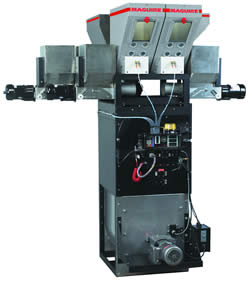High-Volume Blenders are Key for Compounders, High-Throughput Extrusion Processors, and Plastic/Wood Composites Manufacturers

A super-sized gravimetric blender of innovative design is required for plastics processors with very high-throughput production lines. Such a blender must be capable of precisely and efficiently dosing large quantities of hard-to-handle bulk powders like additives and wood flour.
A blender for these applications must be equipped to accommodate more ingredients than standard blenders. Ideally, it will have several removable hoppers and various dispensing methods, suitable for ingredients with different properties. Removable hoppers also allow the ingredients to be changed quickly for end products that have different properties or colors.
The basic operation of a high-volume blender is basically the same as other blenders. Ingredients are dispensed sequentially into a weigh chamber; the batch then falls into a mixing chamber. The dispensing devices include vertical valves (for resin pellets and regrind) and auger feeders (for powders, granules, and pulverized materials). Because the hoppers are interchangeable, it is easy to accommodate variations in batch recipe.
This kind of blending system should enable companies with the greatest volumes to achieve the same exceedingly fine control over ingredient consumption and batch consistency that smaller blenders have long made available to other processors.
A blender of this caliber may be supplied with a microprocessor controller but a high quality touch screen with Ethernet capability is desirable. In either case, the controller should automatically make small corrections from batch to batch, including adjustments to compensate for variations in extrusion rate or bulk density, maintaining overall batch accuracy to within ± 0.1%.
In the case of costly additives, this level of precision eliminates such wasteful practices as over-coloring to compensate for process variations or for the unreliability of alternative feeding equipment. In addition, because the blender doses colorants and additives in accordance with their weight as percentages of natural resin and automatically adjusts for the presence of these materials in regrind, it eliminates double-dosing. Even for a low-volume operation, the savings in colorant costs alone can yield payback on the cost of the blender in ten to twelve months; for high-throughput operations.



